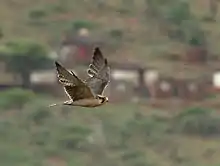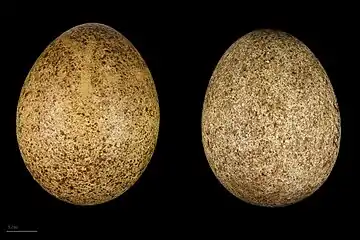Lanner falcon
The lanner falcon (Falco biarmicus) is a medium-sized bird of prey that breeds in Africa, southeast Europe and just into Asia. It prefers open habitat and is mainly resident, but some birds disperse more widely after the breeding season. A large falcon, it preys on birds and bats.[2]
| Lanner falcon | |
|---|---|
 | |
| Adult Falco biarmicus feldeggi | |
| Scientific classification | |
| Kingdom: | Animalia |
| Phylum: | Chordata |
| Class: | Aves |
| Order: | Falconiformes |
| Family: | Falconidae |
| Genus: | Falco |
| Subgenus: | Hierofalco |
| Species: | F. biarmicus |
| Binomial name | |
| Falco biarmicus Temminck, 1825 | |
 | |
| Range of Falco biarmicus Resident Non-breeding Possibly Extant (resident) | |
| Synonyms | |
|
Falco feldeggii Schlegel, 1841 | |
Taxonomy
The lanner falcon was described by the Dutch zoologist Coenraad Jacob Temminck in 1825 under the current binomial name Falco biarmicus.[3] The type locality is Caffraria and the Cape of Good Hope.[4] Falco is Late Latin for a "falcon", from falx, falcis "sickle". The Swedish naturalist Carl Linnaeus had used the specific epithet biarmicus for the bearded reedling and Temminck clearly believed that the word meant "bearded" but it is likely that Linnaeus was using the Latinized form for Bjarmaland, a district in northern Russia.[5] The English word "lanner" is believed to come from the Old French lanier meaning "cowardly". The first recorded use of the word in English is from around 1400.[6]
This is presumably the oldest living hierofalcon species. Support for this assumption comes mainly from biogeography agreeing better with the confusing pattern of DNA sequence data in this case than in others. Nonetheless, there is rampant hybridization (see also perilanner) and incomplete lineage sorting which confounds the data to a massive extent; molecular studies with small sample sizes can simply not be expected to yield reliable conclusions in the entire hierofalcon group.
In any case, the radiation of the entire living diversity of hierofalcons seems to have taken place in the Eemian interglacial at the start of the Late Pleistocene, a mere 130,000–115,000 years ago; the lanner falcons would thus represent the lineage that became isolated in sub-Saharan Africa at some time during the Riss glaciation (200,000 to 130,000 years ago) already.[7][8][9][10]
There are five recognised subspecies:[11]
- F. b. biarmicus Temminck, 1825 – The nominate subspecies, ranges from the Democratic Republic of the Congo to southern Kenya south to South Africa
- F. b. feldeggii Schlegel, 1843 – Italy to Turkey, Azerbaijan and northwestern Iran
- F. b. tanypterus Schlegel, 1843 – northeastern Africa to Arabia, Israel and Iraq
- F. b. erlangeri Kleinschmidt, O., 1901 – northwestern Africa
- F. b. abyssinicus Neumann, 1904 – southern Mauritania to Ethiopia and Somalia south to Cameroon and northern Kenya
Description


It is a large falcon, at 43–50 cm (17–20 in) length with a wingspan of 95–105 cm (37–41 in). European lanner falcons (Falco biarmicus feldeggi, also called Feldegg's falcon) have slate grey or brown-grey upperparts; most African subspecies are a paler blue grey above. The breast is streaked in northern birds, resembling greyish saker falcons, but the lanner has a reddish back to the head. Sexes are similar, but the browner young birds resemble saker falcons even more. However, sakers have a lighter top of the head and less clear head-side patterns. The lanner's call is a harsh "wray-e".
Distribution and habitat
The lanner falcon is a bird of open country and savanna. It usually hunts by horizontal pursuit, rather than the peregrine falcon's stoop from a height, and takes mainly bird prey in flight. It lays three to four eggs on a cliff ledge nest, or occasionally in an old stick nest in a tree.
They are bred in captivity for falconry; hybrids with the peregrine ("perilanners") are also often seen. Merret (1666) claimed that the "lanar" lived in Sherwood Forest and the Forest of Dean in England; such populations would seem to have derived from escaped hunting birds of the nobility.[12]
In the wild, lanner falcon numbers are somewhat declining in Europe, though the species remains relatively common in parts of Africa. In the Degua Tembien mountains of Ethiopia, it was observed to contribute to controlling pest rodents.[13]
Jackdaw flocks are targets of coordinated hunting by pairs of lanner falcons, although larger flocks are more able to elude becoming prey.[14] In Africa and Israel, lanner falcons were observed as hunting bats.[15]
Gallery
 Painting by John Gerrard Keulemans (1884)
Painting by John Gerrard Keulemans (1884) Lanner falcon at Plettenberg Bay, South Africa
Lanner falcon at Plettenberg Bay, South Africa Adult Falco biarmicus biarmicus, Etosha National Park, Namibia.
Adult Falco biarmicus biarmicus, Etosha National Park, Namibia. A falconer's lanner in a dive. Note distinct head coloration.
A falconer's lanner in a dive. Note distinct head coloration. Juvenile, probably F. b. feldeggi. Note blue facial skin and overall similarity to saker falcon.
Juvenile, probably F. b. feldeggi. Note blue facial skin and overall similarity to saker falcon. Falco biarmicus feldeggii - MHNT
Falco biarmicus feldeggii - MHNT Falco biarmicus erlangeri - MHNT
Falco biarmicus erlangeri - MHNT
Notes
References
- BirdLife International. 2016. Falco biarmicus. The IUCN Red List of Threatened Species 2016: e.T22696487A93567240. https://doi.org/10.2305/IUCN.UK.2016-3.RLTS.T22696487A93567240.en. Downloaded on 26 July 2020.
- Mikula, P.; Morelli, F.; Lučan, R. K.; Jones, D. N.; Tryjanowski, P. (2016). "Bats as prey of diurnal birds: a global perspective". Mammal Review. 46 (3): 160–174. doi:10.1111/mam.12060.
- Temminck, Coenraad Jacob (1825). Nouveau recueil de planches coloriées d'oiseaux, pour servir de suite et de complément aux planches enluminées de Buffon (in French). Volume 1. Paris: F.G. Levrault. Plate 324. The 5 volumes were originally issued in 102 parts, 1820-1839
- Mayr, Ernst; Cottrell, G. William, eds. (1979). Check-list of Birds of the World. Volume 1 (2nd ed.). Cambridge, Massachusetts: Museum of Comparative Zoology. p. 419.
- Jobling, James A. (2010). The Helm Dictionary of Scientific Bird Names. London: Christopher Helm. pp. 71, 151. ISBN 978-1-4081-2501-4.
- "lanner". Oxford English Dictionary (Online ed.). Oxford University Press. (Subscription or participating institution membership required.)
- Helbig, A.J.; Seibold, I.; Bednarek, W.; Brüning, H.; Gaucher, P.; Ristow, D.; Scharlau, W.; Schmidl, D.; Wink, Michael (1994). Meyburg, B.-U.; Chancellor, R.D. (eds.). Phylogenetic relationships among falcon species (genus Falco) according to DNA sequence variation of the cytochrome b gene (PDF). Raptor conservation today. pp. 593–599.
- Wink, Michael; Seibold, I.; Lotfikhah, F.; Bednarek, W. (1998). Chancellor, R.D.; Meyburg, B.-U.; Ferrero, J.J. (eds.). Molecular systematics of holarctic raptors (Order Falconiformes) (PDF). Holarctic Birds of Prey. Adenex & WWGBP. pp. 29–48.
- Nittinger, F.; Haring, E.; Pinsker, W.; Wink, Michael; Gamauf, A. (2005). "Out of Africa? Phylogenetic relationships between Falco biarmicus and other hierofalcons (Aves Falconidae)" (PDF). Journal of Zoological Systematics and Evolutionary Research. 43 (4): 321–331. doi:10.1111/j.1439-0469.2005.00326.x.
- Wink, Michael; Sauer-Gürth, Hedi; Ellis, David; Kenward, Robert (2004). Chancellor, R.D.; Meyburg, B.-U. (eds.). Phylogenetic relationships in the Hierofalco complex (Saker-, Gyr-, Lanner-, Laggar Falcon) (PDF). Raptors Worldwide. Berlin: WWGBP. pp. 499–504.
- Gill, Frank; Donsker, David, eds. (2017). "Falcons". World Bird List Version 7.3. International Ornithologists' Union. Retrieved 14 November 2017.
- Merret, Christopher (1666). Pinax rerum naturalium Britannicarum continens vegetabilia, animalia et fossilia, in hac insula reperta inchoatus (in Latin). London: Pulleyn and F. & T. Warren.
- Meheretu Yonas; Leirs, H (2019). Raptor perch sites for biological control of agricultural pest rodents. In: Nyssen J., Jacob, M., Frankl, A. (Eds.). Geo-trekking in Ethiopia's Tropical Mountains - The Dogu'a Tembien District. SpringerNature. ISBN 978-3-030-04954-6.
- Leonardi, Giovanni (1999). "Cooperative hunting of Jackdaws by the Lanner Falcon (Falco biarmicus)" (PDF). Journal of Raptor Research. 33 (2): 123–127.
- Mikula, P.; Morelli, F.; Lučan, R. K.; Jones, D. N.; Tryjanowski, P. (2016). "Bats as prey of diurnal birds: a global perspective". Mammal Review. 46 (3): 160–174. doi:10.1111/mam.12060.
- Sharpe, Richard Bowdler (1874). Catalogue of the birds in the British Museum. 1. London: British Museum (Natural History).
- Strickland, Hugh Edwin (1855). Ornithological Synonyms. London: J. Van Voorst.
External links
| Wikimedia Commons has media related to Falco biarmicus. |
| Wikispecies has information related to Falco biarmicus. |
- Lanner falcon species text in The Atlas of Southern African Birds.
- BirdLife species factsheet for Falco biarmicus
- "Falco biarmicus". Avibase.

- "Lanner falcon media". Internet Bird Collection.
- Lanner falcon photo gallery at VIREO (Drexel University)
- Interactive range map of Falco biarmicus at IUCN Red List maps
- Audio recordings of Lanner falcon on Xeno-canto.
